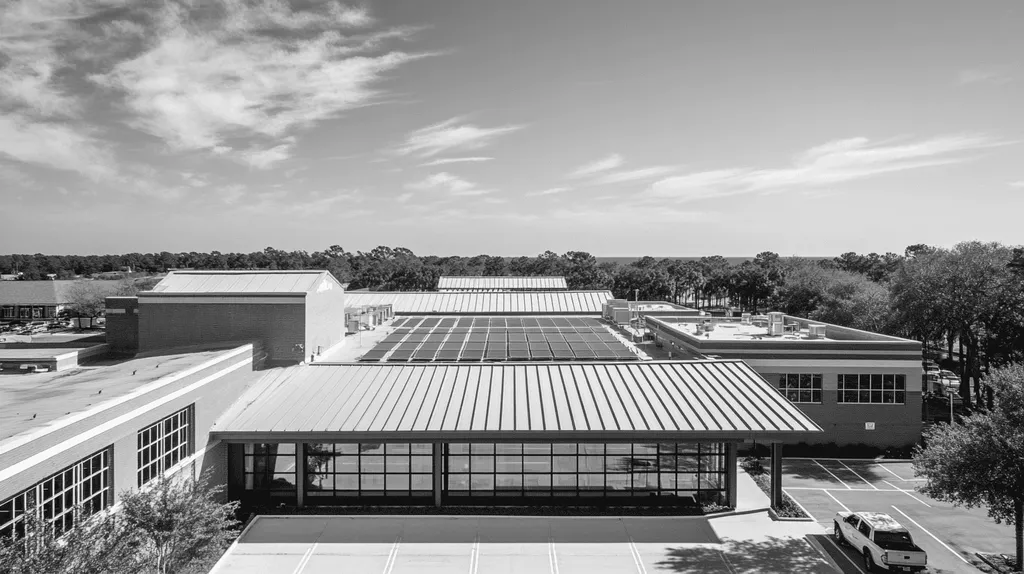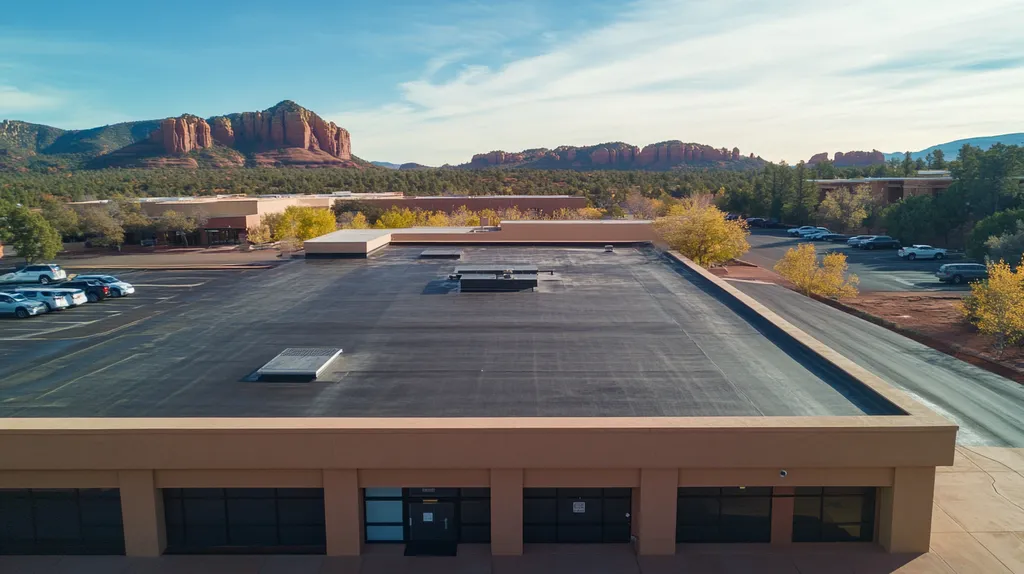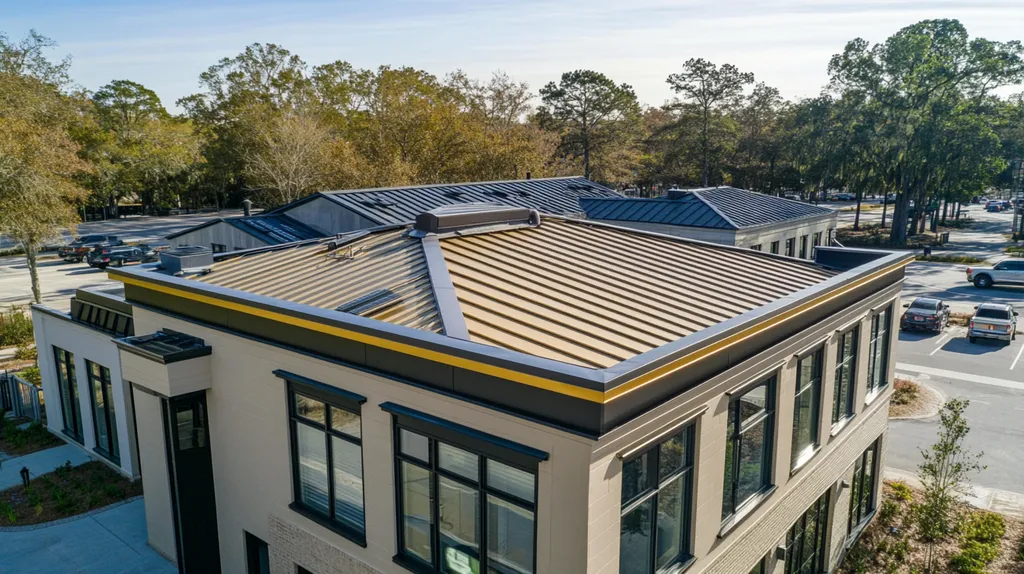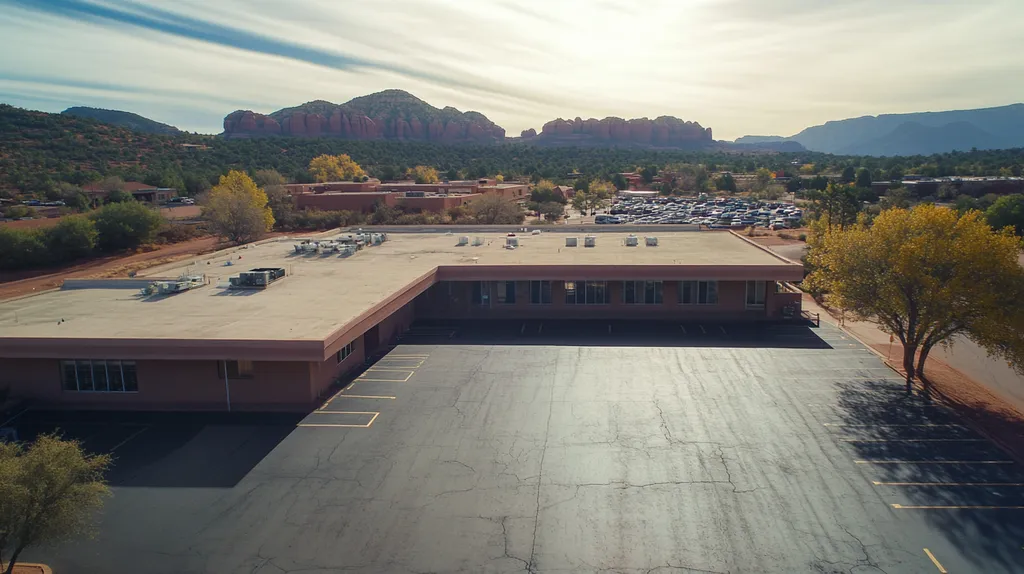When a commercial roof springs a leak at 2 AM during a thunderstorm, every minute counts. Studies show that water damage from roof failures costs U.S. businesses over $5 billion annually in lost inventory, equipment damage, and operational disruptions.
Having the right emergency repair materials on hand – and knowing how to use them effectively – can mean the difference between a quick fix and a catastrophic failure. From temporary patches to permanent solutions, today’s commercial roofers have access to an array of innovative materials designed for rapid deployment.
This comprehensive guide explores the essential materials, tools, and techniques needed to tackle emergency commercial roof repairs with confidence and precision.
SECTION 1: FUNDAMENTAL CONCEPTS
When a roofing emergency strikes, it can put a quick stop to business operations and lead to steep financial losses. With over 40% of roofing issues linked to inadequate maintenance, understanding roofing materials, common defects, and essential emergency repair principles is vital for commercial property owners and facility managers. This knowledge empowers them to act swiftly, keeping their operations running smoothly while minimizing disruption and costs.
Types of Roofing Materials
Knowing the different roofing materials is key to tackling emergencies effectively. Common options like TPO, EPDM, PVC, and built-up systems each come with distinct characteristics and weaknesses.
TPO (Thermoplastic Olefin) is celebrated for energy efficiency and affordability, but its susceptibility to punctures during extreme weather can be a challenge. On the flip side, EPDM (Ethylene Propylene Diene Monomer) boasts remarkable durability, yet it can degrade under harmful UV exposure if not properly maintained.
PVC roofs shine in environments that demand strong chemical resistance, making them ideal for facilities dealing with harsh substances. Built-up roofing systems provide robust protection through multiple layers but may bring more complex repair needs.
Grasping these material differences enables stakeholders to make informed choices for emergency repairs, ultimately shrinking downtime and protecting their bottom line.
Common Roofing Defects
Roofing defects can escalate into emergencies, demanding immediate solutions. The most frequent culprits include leaks, punctures, and blisters. Leaks can stem from a variety of issues, including poor installation, ongoing wear and tear, or adverse weather conditions.
Punctures often arise from severe weather or maintenance foot traffic. It’s crucial to address them quickly; a small puncture can snowball into a major leak if left unchecked.
Blisters develop when moisture gets trapped beneath the roofing membrane, posing risks to valuable assets stored inside. Regular inspections can help catch these issues early, preventing them from spiraling into emergencies and safeguarding both inventory and personnel.
Being aware of these common defects allows property owners and managers to schedule thoughtful maintenance, reducing risks and avoiding hefty repair bills.
Emergency Repair Principles
In any roofing crisis, quick and decisive action is paramount. The first principle is to secure the area, ensuring the safety of staff and visitors is always the top priority. Once safety is addressed, assessing the damage becomes the critical next step.
This thorough evaluation helps determine if a temporary patch or a lasting solution is necessary. Utilizing the correct materials for the repair, such as roofing tape or waterproof sealants, is also essential for effective results.
Documenting the damage and repair process is not just bureaucratic; it’s vital for future insurance claims and maintenance planning. Finally, implementing a follow-up plan ensures that repairs hold strong and any underlying problems are addressed.
By following these emergency repair principles, property owners can respond quickly, significantly cutting down on downtime and avoiding costly repairs.
SECTION 2: SYSTEM COMPONENTS
When a roof crisis arises, every second counts. Just imagine the financial strain—statistics indicate that a staggering 70% of businesses hit by a significant disruption may cease operations within five years. Grasping the essentials for emergency roof repairs can mean the difference between a swift fix and major structural damage. This section delves into critical components such as roof patches, sealants, roofing tools, and safety gear, each one playing a pivotal role in navigating emergency roofing situations.
Roof Patches and Sealants
Roof patches and sealants are the backbone of quick emergency repairs. These materials serve as urgent solutions to seal leaks and thwart further water intrusion. For example, butyl rubber patches easily stick to a variety of roofing types, forming a waterproof barrier that holds strong until a permanent fix can be achieved.
Foam sealants present another quick-drying option with expanding capabilities, making them perfect for those tricky gaps around pipes and flashing. This adaptability can be a game changer under pressure, particularly when storms threaten further damage.
Choosing the right patching material tailored to the roof type is crucial. A polyurethane sealant often outperforms silicone on metal roofs, as the latter can struggle with adhesion over time. Understanding product compatibility is essential for achieving lasting results.
Knowing how to effectively apply these solutions can significantly slash repair times. Many modern products are designed for easy application, ensuring minimal disruption while safeguarding the roof’s overall integrity.
Roofing Tools and Equipment
The right tools and equipment are indispensable during emergency roofing incidents. Basic essentials include electric or hand-operated roofing knives for precise cuts and trowels for sealant application. These tools not only expedite repairs but also ensure that every leak is sealed with care.
Moreover, having reliable roofing rigs or ladders allows for safe access to rooftops. Never underestimate the importance of safety gear; harnesses and guardrails are crucial for protecting workers while they tackle repairs, helping to avoid potentially harmful accidents.
Investing in portable equipment, like a roofing vacuum, can also accelerate the removal of debris. Clearing the site not only prepares it for repairs but also aids in accurately assessing damage. This preparation is vital for maintaining the roof’s structural integrity and sidestepping further complications.
Being organized and ready with the right tools helps streamline emergency procedures, saving valuable time and minimizing costs during repair operations.
Safety Gear and Protective Measures
Safety must take precedence during emergency roofing repairs. Property owners should ensure workers are equipped with essential protective gear, including helmets, gloves, and non-slip footwear. Proper safety equipment is crucial to preventing injuries, contributing to a secure work environment.
Beyond personal safety gear, implementing fall protection systems, such as harnesses, safety nets, and guardrails, is vital for any work done at heights. Adhering to OSHA regulations not only enhances safety but also protects against potential legal consequences.
The hazards associated with roofing emergencies can escalate quickly. Establishing a comprehensive safety plan with clear guidelines is key to mitigating these risks. Training workers on proper safety protocols reinforces their protection during critical repairs.
Ultimately, prioritizing safety measures not only protects workers but also preserves the overall investment in roofing by preventing additional damage. A strong focus on safety can significantly improve the effectiveness of emergency repair efforts.
SECTION 3: IMPLEMENTATION METHODS
When a commercial roof suffers damage, swift action is vital. Responding promptly can prevent expansive water damage and minimize costly downtime. Studies reveal that if leaks are left unchecked, they can contribute to over 30% of a building’s maintenance costs. This section unveils essential implementation methods for effective emergency repairs, ensuring property owners and facility managers are primed to act fast and decisively.
Applying Roof Patches and Sealants
Roof patches and sealants are the first line of defense in emergency repairs. These materials can rapidly cover leaks or tears, establishing a watertight seal. When applied correctly, they create an immediate barrier against unwanted moisture intrusion.
Commercial roofs frequently endure unexpected damage from harsh weather, falling debris, or the effects of aging materials. Selecting high-quality patches that are compatible with the existing roof type ensures longevity and effectiveness. For example, rubberized asphalt patches work wonders on built-up roofs, offering a sturdy yet flexible, weather-resistant repair.
Sealants are equally crucial, especially around vulnerable areas like vents, chimneys, and skylights. Easy to apply and available in various formulations to match different roofing surfaces, they serve as an excellent temporary solution. Regular maintenance inspections can help identify regions that may require these quick fixes.
Ultimately, while roof patches and sealants are indispensable stopgap measures, ongoing inspections are critical to assessing the necessity of permanent repairs.
Using Quick-Setting Adhesives
Quick-setting adhesives are vital during emergency roofing scenarios. Their rapid-curing properties allow for prompt application when time is of the essence. These adhesives create strong bonds on materials such as TPO, PVC, and EPDM roofing membranes, making them a go-to choice for urgent situations.
Consider a sudden leak; employing a quick-setting adhesive can secure loose membranes and halt further water intrusion within moments. Proper application can significantly reduce repair time and protect the interior of the building from further damage.
Designed to endure various temperatures and environmental conditions, these adhesives are suitable for use in diverse climates. However, ensuring that the surfaces are clean and dry prior to application is crucial for achieving the best results.
Utilizing quick-setting adhesives can drastically minimize downtime and safeguard assets while providing a temporary fix until comprehensive repairs can be carried out.
Temporary vs. Permanent Repairs
Understanding the difference between temporary and permanent repairs is key to effective roofing management. Temporary repairs aim to mitigate immediate risks, while permanent solutions focus on ensuring long-term stability.
Temporary fixes like patches and sealants provide immediate protection against leaks, but they are often stopgaps that need eventual follow-up. For instance, using a tarp to cover a damaged area may offer quick relief but should be replaced with a more durable solution at the first opportunity.
Permanent repairs, however, involve more extensive steps, such as replacing damaged sections of the roof or even installing a new roofing system. Although these repairs demand more resources and time, they ultimately guarantee that the roof will endure against future challenges.
Property owners and facility managers should regularly inspect their roofs and prioritize permanent repairs as needed. This proactive strategy not only protects their investment but also enhances the safety and comfort of everyone within the building.
SECTION 4: MAINTENANCE REQUIREMENTS
Emergency roof repairs can cost commercial property owners thousands of dollars, making proactive maintenance a critical investment. Regular upkeep helps identify potential issues before they escalate into costly emergencies. In fact, studies show that staying ahead with maintenance can extend the lifespan of a roof by 30% or more. This section explores the importance of regular inspections, preventive strategies, and the urgency of addressing minor repairs quickly.
Regular Roof Inspections
Routine roof inspections are pivotal for preserving a commercial roof’s integrity. Property owners should aim to schedule these assessments at least twice a year, ideally before and after severe weather seasons. This timing helps catch any storm-related damage without delay.
During these inspections, skilled professionals look for hidden issues such as membrane punctures or weakened flashings. Identifying these problems early can prevent larger leaks that compromise the building’s interior. For instance, minor wear on overlapping seams can potentially lead to significant leaks if unnoticed.
Regular inspections also allow maintenance teams to maintain an accurate record of the roof’s condition. This documentation is invaluable for budgeting future repairs or replacements, as well as assisting with warranty claims when needed.
In conclusion, routine inspections save money and contribute to a roof’s longevity. Overlooking this vital step can lead to extensive damage and ultimately devalue the property.
Preventive Maintenance Strategies
Preventive maintenance serves as an essential defense against unexpected roof failures. Implementing a systematic approach keeps the roof in top condition and can significantly reduce repair costs over time. A key aspect is regularly cleaning gutters and downspouts to ensure proper water drainage.
Property owners must also address issues like pooling water promptly. Standing water can deteriorate roofing materials quickly, leading to leaks and structural damage. For example, installing tapered insulation can redirect water flow and minimize water accumulation risks.
Additionally, applying protective coatings can enhance a roof’s lifespan. These coatings act as extra barriers against ultraviolet (UV) rays and weathering while improving energy efficiency by reflecting sunlight and reducing heat absorption.
Overall, preventive maintenance encompasses a variety of strategies. By adopting these proactive measures, property owners can mitigate risks and help their roofs withstand the test of time.
Addressing Minor Leaks and Damages
Swiftly tackling minor leaks and damages is crucial for preserving commercial roofs. Small issues, if ignored, can escalate into major problems, leading to expensive repairs and business disruptions. For instance, a pinhole leak can compromise insulation and result in mold growth if not resolved promptly.
Common minor repairs include sealing cracks and replacing damaged shingles or tiles. These quick fixes can often be handled in-house by maintenance staff skilled in basic roofing techniques. However, more significant repairs are best left to qualified roofing contractors.
Using quality materials for these minor repairs is essential. For example, roofing sealants and patches designed for specific materials ensure longer-lasting results. In the long run, investing in high-quality repair products can save money and prevent further damage.
To sum up, vigilant monitoring and prompt action regarding minor leaks and damages can safeguard the integrity of a commercial roof. By fostering a proactive repair culture, property owners can protect their buildings from the risks that come with neglect.
SECTION 5: PERFORMANCE METRICS
After an emergency roof repair, evaluating how well the materials have performed is crucial for keeping your property safe and sound. Flawed repairs can lead to leaks, structural damage, and significant financial losses. Research suggests that improper repairs can inflate long-term maintenance costs by as much as 30%. This section dives into the essential metrics for evaluating repair effectiveness, ensuring water tightness, and monitoring structural integrity.
Evaluating Repair Effectiveness
To gauge the effectiveness of emergency roof repairs, property owners should embrace systematic evaluation methods. Start with visual inspections, keeping an eye out for signs of wear, gaps, or separation, which may signal potential problems. The quality of the repair work can often reveal itself through these visual cues.
Next up, moisture meters are invaluable. These nifty tools help detect any lingering dampness hidden beneath the roofing layers, uncovering issues that could jeopardize the integrity of the repair.
Don’t forget about thermal imaging technology! This innovative method reveals temperature inconsistencies, spotlighting areas where repairs might have faltered. When combined, these techniques offer a thorough assessment of repair performance.
Moreover, establishing clear performance criteria prior to repairs lays the groundwork for better evaluations later. This proactive attitude ensures that future decisions are based on solid data, not educated guesses.
Assessing Water Tightness
Water tightness should be a top-tier metric for emergency roofing repairs. Once repairs are complete, conducting water tests is vital to confirm no leaks remain. This involves applying controlled water to the repaired areas in a manner that mimics real rain conditions.
Pay special attention to seams and flashing, as these are common points of failure. Careful inspections in these areas can prevent long-term damage from overlooked vulnerabilities.
Establishing a regular inspection schedule helps maintain water tightness over time, allowing property owners to catch early signs of wear and tear. By addressing issues before they worsen, they can preempt costly repairs.
Analyzing water penetration patterns over time will inform future repair choices. Understanding how water interacts with different roofing materials will help property owners make better, more informed decisions moving forward.
Monitoring Structural Integrity
After emergency repairs, keeping an eye on the roof’s structural integrity is essential. Property owners should actively check for sagging, warping, or irregularities that might indicate deeper issues. Such problems can threaten the entire building’s safety.
Using structural sensors can offer real-time data on stress and load conditions. This innovative technology identifies problematic areas before they escalate, facilitating earlier interventions.
Scheduled load assessments are also critical for ensuring the roof withstands environmental stressors like heavy rain and snow. This practice helps prevent undue strain on repaired areas and maintains the roof’s integrity.
Lastly, regular maintenance checks conducted by qualified professionals are crucial for prolonging the life of the roof. Implementing a routine maintenance program not only preserves structural integrity but also enhances overall performance.
SECTION 5: PERFORMANCE METRICS
After tackling an emergency roof repair, evaluating the chosen materials’ performance is absolutely vital to maintain your property’s safety. Flawed repairs can lead to leaks, structural problems, and hefty financial repercussions down the line. Research indicates that inadequate repairs can cause maintenance costs to soar by up to 30%. This section explores how to assess repair effectiveness, ensure water tightness, and monitor structural integrity without losing a beat.
Evaluating Repair Effectiveness
To effectively assess emergency roof repairs, property owners should adopt systematic evaluation techniques. Visual inspections play a key role, focusing on signs of wear and tear, misalignment, or separation that could reveal potential issues down the line.
Next on the agenda: moisture meters! These handy devices allow for precise detection of any lingering dampness lurking beneath the roofing layers. They are essential for uncovering hidden concerns that could compromise the integrity of the repairs.
And let’s not forget thermal imaging technology, which highlights temperature anomalies to pinpoint areas where fixes may have fallen short. Combining these methods offers a complete picture of the repair’s performance.
Setting clear performance criteria before repairs begins creates a solid framework for post-repair evaluations. This proactive mindset guarantees that future decisions are founded on reliable data rather than mere assumptions.
Assessing Water Tightness
Water tightness isn’t just a nice-to-have; it’s a must-have metric following emergency roofing repairs. Conducting thorough water tests post-repair is imperative to confirm that no leaks remain. This testing involves applying controlled water in a way that mimics real rain conditions to ensure robust protection.
Property owners should pay close attention to seams and flashing, which are frequent failure points during these assessments. Diligently inspecting these areas helps prevent long-term damage caused by overlooked vulnerabilities.
Establishing a regular inspection schedule fortifies water tightness over time. This proactive measure allows property owners to catch early signs of deterioration, enabling timely maintenance actions.
Tracking water penetration patterns across multiple inspections is insightful. By understanding the interactions between different roofing materials and water, property owners can inform more effective repair decisions moving forward.
Monitoring Structural Integrity
Post-emergency repairs, monitoring the roof’s structural integrity is more important than ever. Property owners should keep an eye out for sagging, warping, or other irregularities that could indicate deeper issues, as these can potentially jeopardize the overall safety of the building.
Utilizing structural sensors can provide real-time insights into stress and load conditions, catching potential trouble spots before they escalate. This advanced technology paves the way for earlier interventions, reducing risks significantly.
In addition, periodic load assessments ensure that the roof can withstand environmental stress, like heavy rains or snow overloads. Monitoring these factors is crucial to prevent undue strain on repaired areas.
Lastly, routine maintenance checks performed by qualified professionals are essential in maintaining the roof’s longevity. Establishing a regular maintenance program not only protects structural integrity but also optimizes overall performance for years to come.
Moving Forward
With commercial roof damage costing businesses billions annually, having the right emergency repair materials and knowledge is no longer optional – it’s essential for survival.
The latest innovations in patches, sealants, and quick-setting adhesives have transformed how facility managers handle roofing emergencies, cutting response times by up to 60% when properly deployed.
Yet materials alone aren’t enough – success demands a comprehensive approach combining regular inspections, preventive maintenance, and performance monitoring.
By implementing the strategies outlined in this guide, property owners and facility managers can dramatically reduce emergency repair costs while extending their roofs’ lifespans by 25% or more.
The future of commercial roofing lies not just in reacting to emergencies, but in preventing them through smart material choices and proactive maintenance.
FREQUENTLY ASKED QUESTIONS
Q. What are the key materials for emergency commercial roof repairs?
A. Key materials include roofing patches, sealants, and quick-setting adhesives. Understanding these materials helps you make informed choices during emergencies. Patches provide immediate leak coverage, while sealants address vulnerable areas. Quick-setting adhesives are invaluable in urgent situations, ensuring none of that pesky rain sneaks in!
Q. How can I ensure my industrial roof is safe during emergencies?
A. Safety is crucial during emergencies. Equip workers with helmets, gloves, and non-slip footwear. Implement fall protection systems like harnesses and guardrails for work at heights. Establishing a safety plan and training workers on safety protocols ensures that everyone stays protected while addressing roof repairs!
Q. How do I quickly apply roof patches and sealants?
A. Start by cleaning and drying the area needing repair. For patches, cut a suitable size and press down firmly on the leak. Apply sealants around vulnerable areas like vents or seams. Ensuring proper application means you can effectively seal those pesky leaks and prevent further damage!
Q. What minor damages should I address on my commercial roof?
A. Address small issues like cracks, pinhole leaks, or damaged shingles immediately. These minor repairs can often be done in-house, avoiding larger problems later. Using quality materials for these quick fixes ensures a longer-lasting solution, keeping your roof—and business—protected from further issues!
Q. How can I assess the effectiveness of emergency repairs?
A. Evaluate the repairs through visual inspections for signs of wear or gaps. Utilize moisture meters to check for lingering dampness, and consider thermal imaging technology for a comprehensive assessment. These techniques help ensure your emergency repairs hold up over time and perform effectively!
Q. What preventive maintenance steps can extend my roof’s lifespan?
A. Schedule regular inspections and clean gutters to maintain proper drainage. Address pooling water promptly, as it can deteriorate roofing materials. Applying protective coatings also enhances your roof’s durability, reflecting sunlight and reducing heat absorption. A little maintenance goes a long way to extend its lifespan!
Q. How should I handle temporary versus permanent roof repairs?
A. Temporary repairs offer immediate solutions, such as patches and sealants. However, be mindful that these should not replace permanent fixes. Permanent repairs involve more extensive work, like replacing damaged sections or installing a new roof. Regular inspections will help prioritize long-term solutions for your roofing needs!










